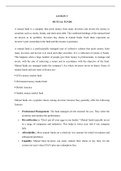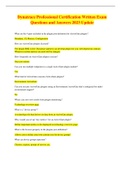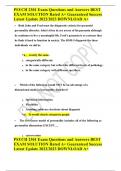LESSON V
MUTUAL FUNDS
A mutual fund is a company that pools money from many investors and invests the money in
securities such as stocks, bonds, and short-term debt. The combined holdings of the mutual fund
are known as its portfolio. Investors buy shares in mutual funds. Each share represents an
investor’s part ownership in the fund and the income it generates.
A mutual fund is a professionally managed type of collective scheme that pools money from
many investors and invests it in stock and other securities. It is a collection of stocks or bonds.
This happens when a large number of people give their money to professionals, to manage and
invest, with the aim of achieving a return and in accordance with the objective of the fund.
Mutual funds are managed under the company’s Act where investors invest in shares. Some of
mutual funds and unit trusts in Kenya are:-
ICEA money market fund
Old mutual money market fund
British America
Stanbic money market fund
Mutual funds are a popular choice among investors because they generally offer the following
features:
Professional Management. The fund managers do the research for you. They select the
securities and monitor the performance.
Diversification or “Don’t put all your eggs in one basket.” Mutual funds typically invest
in a range of companies and industries. This helps to lower your risk if one company
fails.
Affordability. Most mutual funds set a relatively low amount for initial investment and
subsequent purchases.
Liquidity. Mutual fund investors can easily redeem their shares at any time, for the
current net asset value (NAV) plus any redemption fees.
, Types of Mutual Funds
Most mutual funds fall into one of four main categories – money market funds, bond funds, stock
funds, and target date funds. Each type has different features, risks, and rewards.
Money market funds have relatively low risks. By law, they can invest only in certain
high-quality, short-term investments issued by corporations, and state and local
governments.
Bond funds have higher risks than money market funds because they typically aim to
produce higher returns. Because there are many different types of bonds, the risks and
rewards of bond funds can vary dramatically.
Stock funds invest in corporate stocks. Not all stock funds are the same. Some examples
are:
o Growth funds focus on stocks that may not pay a regular dividend but have
potential for above-average financial gains.
o Income funds invest in stocks that pay regular dividends.
o Index funds track a particular market index such as the Standard & Poor’s 500
Index.
o Sector funds specialize in a particular industry segment.
Target date funds hold a mix of stocks, bonds, and other investments. Over time, the
mix gradually shifts according to the fund’s strategy. Target date funds, sometimes
known as lifecycle funds, are designed for individuals with particular retirement dates in
mind.
Benefits of Mutual Funds
Mutual funds offer professional investment management and potential diversification. They also
offer three ways to earn money:
Dividend Payments. A fund may earn income from dividends on stock or interest on
bonds. The fund then pays the shareholders nearly all the income, less expenses.
MUTUAL FUNDS
A mutual fund is a company that pools money from many investors and invests the money in
securities such as stocks, bonds, and short-term debt. The combined holdings of the mutual fund
are known as its portfolio. Investors buy shares in mutual funds. Each share represents an
investor’s part ownership in the fund and the income it generates.
A mutual fund is a professionally managed type of collective scheme that pools money from
many investors and invests it in stock and other securities. It is a collection of stocks or bonds.
This happens when a large number of people give their money to professionals, to manage and
invest, with the aim of achieving a return and in accordance with the objective of the fund.
Mutual funds are managed under the company’s Act where investors invest in shares. Some of
mutual funds and unit trusts in Kenya are:-
ICEA money market fund
Old mutual money market fund
British America
Stanbic money market fund
Mutual funds are a popular choice among investors because they generally offer the following
features:
Professional Management. The fund managers do the research for you. They select the
securities and monitor the performance.
Diversification or “Don’t put all your eggs in one basket.” Mutual funds typically invest
in a range of companies and industries. This helps to lower your risk if one company
fails.
Affordability. Most mutual funds set a relatively low amount for initial investment and
subsequent purchases.
Liquidity. Mutual fund investors can easily redeem their shares at any time, for the
current net asset value (NAV) plus any redemption fees.
, Types of Mutual Funds
Most mutual funds fall into one of four main categories – money market funds, bond funds, stock
funds, and target date funds. Each type has different features, risks, and rewards.
Money market funds have relatively low risks. By law, they can invest only in certain
high-quality, short-term investments issued by corporations, and state and local
governments.
Bond funds have higher risks than money market funds because they typically aim to
produce higher returns. Because there are many different types of bonds, the risks and
rewards of bond funds can vary dramatically.
Stock funds invest in corporate stocks. Not all stock funds are the same. Some examples
are:
o Growth funds focus on stocks that may not pay a regular dividend but have
potential for above-average financial gains.
o Income funds invest in stocks that pay regular dividends.
o Index funds track a particular market index such as the Standard & Poor’s 500
Index.
o Sector funds specialize in a particular industry segment.
Target date funds hold a mix of stocks, bonds, and other investments. Over time, the
mix gradually shifts according to the fund’s strategy. Target date funds, sometimes
known as lifecycle funds, are designed for individuals with particular retirement dates in
mind.
Benefits of Mutual Funds
Mutual funds offer professional investment management and potential diversification. They also
offer three ways to earn money:
Dividend Payments. A fund may earn income from dividends on stock or interest on
bonds. The fund then pays the shareholders nearly all the income, less expenses.








